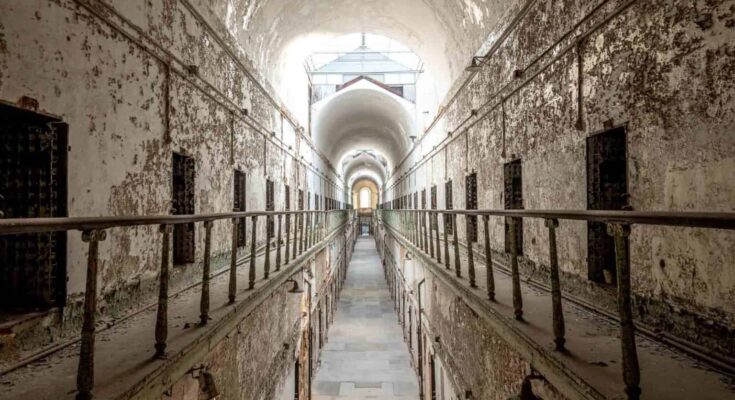The main cell block
History
From 1829 through 1971, Eastern State Penitentiary served as a penitentiary in Philadelphia, Pennsylvania, in the United States. It is currently a National Historic Landmark and offers tours to the general public.
With the notion that isolation would aid in their rehabilitation, the prison was built to house inmates in solitary confinement. Cellblocks fanning out from a central hub formed the prison’s characteristic radial architecture, which was designed to make it easier for the guards to monitor every prisoner from a single place.

Ruins of a solitary cell block
The prison’s population grew over time, and the convicts’ living circumstances deteriorated. The jail was decommissioned in 1971 despite attempts made during the 20th century to modernise it and enhance inmates’ living circumstances.
Since that time, Eastern State Penitentiary has been left unattended, and most of the facility has deteriorated. The historic site has been preserved, though, and public access has been provided. The jail is today a well-liked tourist destination, renowned for its eerie ambiance and significance to the development of the American penal system.
For more than 140 years—from 1829 to 1971—the penitentiary housed prisoners. Before intentions to turn the facility into an attraction materialised, the facility was abandoned and left in ruins for a number of years. However, a large portion of the facility is still in disrepair.
Overview

Guard tower over the stone cell blocks
It’s difficult to miss this imposing building in Fairmount that has large windows and high walls that give it the appearance of a castle. It is a commanding fortress. And it is on purpose. But many of the prison’s intimidating elements are fake.
The intimidating structure could make you feel shivery when you first see it. The gloomy walls seem foreboding. The prison’s mediaeval façade looks menacing. You will see 30-foot barrel-vaulted passageways, skylights, and huge windows as you move through the blocks. The edifice seems to be filled with terror in every crevice.
The atmosphere becomes more gloomy as you walk along the hallways. The furniture and the cells have both been preserved. Even today, visitors are still frightened by the vaulted cells. There was a toilet, central heating, a skylight, and running water in every cell. The offenders could exercise in a running yard that was connected to their cells and enclosed by a ten-foot wall.
The inmates here had a difficult existence. They couldn’t visit with friends or family. Even conversing with the guards was limited. You can read horrifying accounts of captives who spent years in this facility alone. The system’s creators didn’t want the inmates to interact with anyone or have any knowledge of the structure. When they were taken out of their cells, they were hooded. The convicts were required to keep quiet. If they attempted to communicate with one another via gaps in the walls, they would suffer harsh punishment.
450 cells in 3 buildings were originally planned for the prison, but the project proved to be too expensive. Later, with the same footprint, a second and third story were added.

Entrance to the medical ward
Visit the Hospital Block if you wish to see the prison’s medical facilities. Among the most fascinating items in the entire prison are the medical artefacts on show here. The remnants of the lab, operating room, x-ray lab, dentistry clinic, and mental division are visible.

Dental chair
Photographers love to visit Eastern State Penitentiary and use the available light to capture the abandoned building, vacant cells, collapsing walls and open yards. Filming for films and television shows frequently takes place inside this prison. Additionally, Philly music videos have made use of it.

The scale of the prison is imposing
Famous Inmates

Al Capone’s prison cell
This prison had its fair share of fame. Famous felons like bandit Al Capone and bank robber Slick Willie Sutton resided there.
For the first time, Al Capone was sent behind bars for carrying a concealed weapon. He was given a luxurious cell directly inside the door. A radio, a cigar stand, and a second bed were all in Capone’s cell. His cell has been faithfully rebuilt as part of the tour to give you a sense of the two years he spent here in the 1920s. The cell, which is in the prison’s “Park Avenue” sector, is a crowd favourite because of how lifelike it appears.

Art exhibit featuring the portraits of inmate’s victims

